 Recently I took another trip down to see some family in California. My dad and family have been very generous to let me stay there as a way to get away from The Dalles for a while whenever I can. I even had a good time on the way back taking these pictures which would highlight my trip. Your going to have to wait for the next spider. When I do have that footage processed and I'm done with compiling the huge number of pictures--it will be a new series of spider shots like nothing I've ever shown you on this website! Keep coming back after the Holidays.
Recently I took another trip down to see some family in California. My dad and family have been very generous to let me stay there as a way to get away from The Dalles for a while whenever I can. I even had a good time on the way back taking these pictures which would highlight my trip. Your going to have to wait for the next spider. When I do have that footage processed and I'm done with compiling the huge number of pictures--it will be a new series of spider shots like nothing I've ever shown you on this website! Keep coming back after the Holidays.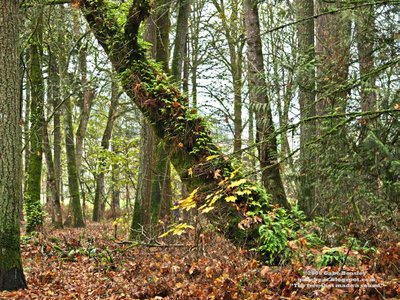 It was actually on my way back that I ran into some interesting winter scenes in Portland. On a walk in Cook Park, I shot pictures of many ferns and notice the lack of undergrowth which is usually present. This might be due to a recent river flood, I am not sure. Don't forget to click on the image for a larger picture and don't forget how to GET BACK with your back arrow located at the top left hand corner of your screen (the one you use to go back in any Internet situation)
It was actually on my way back that I ran into some interesting winter scenes in Portland. On a walk in Cook Park, I shot pictures of many ferns and notice the lack of undergrowth which is usually present. This might be due to a recent river flood, I am not sure. Don't forget to click on the image for a larger picture and don't forget how to GET BACK with your back arrow located at the top left hand corner of your screen (the one you use to go back in any Internet situation) My uncle Ron, a fellow photographer and mentor feeds a Squirrel which grabs the food and makes a hasty retreat. As in most of my pictures, the motion blur here is entirely real and not computer created.
My uncle Ron, a fellow photographer and mentor feeds a Squirrel which grabs the food and makes a hasty retreat. As in most of my pictures, the motion blur here is entirely real and not computer created.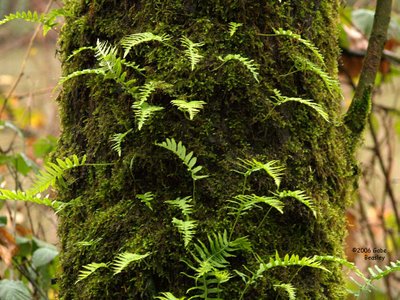 Ferns naturally grow where they can, all the way up this tree-trunk. I have several other pictures and "tree-scapes". Some of which I want to get posted in a local art gallery. Some of my pictures will be up for sale if all goes well in The Dalles here in the next few months in a local gallery. I am not sure as yet when or how this will work. Some friends of mine and family are plan to help me with this.
Ferns naturally grow where they can, all the way up this tree-trunk. I have several other pictures and "tree-scapes". Some of which I want to get posted in a local art gallery. Some of my pictures will be up for sale if all goes well in The Dalles here in the next few months in a local gallery. I am not sure as yet when or how this will work. Some friends of mine and family are plan to help me with this.
A new tree breaks first light in the forest floor.
Being up in the mountains on the way back there was allot to think about shooting. My mind was mostly on a recent re-discovery of my photographic philosophy (as is shown in the above 35mm post). I was taking way too many pictures and I accidentally stepped back to 35mm and re-understand certain things. The limits of 35mm define what might sometimes be far better art. I admit I have a hard time dealing with thousands of anything, or even 100s. Taking that many pictures just drags out a backlog impossible to work with. I learned that each picture has a life of it's own. Each picture has a trait that is not perfect and that might define it as art. The drive for perfection in digital photography at least for me has caused me to sometimes waste my time in frustration and computer space. In my opinion, art is not a subject in which perfection rarely if ever, exists. I take one or two shots and hope they turn out fine rather then 20 when I am using my digital SLR now. There is another reason why shooting many pictures is a problem--shutters can ware-out in digital SLRs allot faster because of overuse. The ware and tear on them can be massive times more then what it would be in a standard film SLR. Think about how many more pictures you take if you started with film and now shoot digital. I find sometimes it is far more rewarding to get one good but "imperfect" shot then to get 1000 pictures with most of the good shots so buried or so over-shot and stuck in my computer files I forget about them or give up frustrated and put off. The excitement I used to have from one roll of film I had forgotten until recently. I now shoot digital as much like that as often as I think of it.
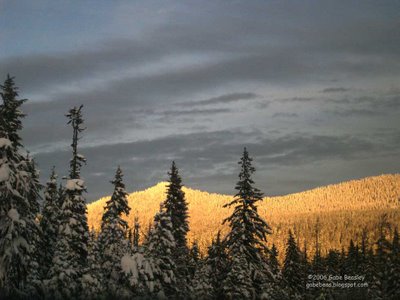 I have never got anything like this before. I may post some of the San Francisco shots later which are from some of the most photographed places in the world. Here is one that’s not! Incredible as it may seem, this image has hardly been digitally altered at all. This is how I saw it. I only brought up the levels a bit to show more of the foreground trees. I happened to snap it at just the right time having just the right manual settings. it was a very difficult shot due to lighting and the fact that I was on a train. The sunset was one of the most incredible I have ever seen.
I have never got anything like this before. I may post some of the San Francisco shots later which are from some of the most photographed places in the world. Here is one that’s not! Incredible as it may seem, this image has hardly been digitally altered at all. This is how I saw it. I only brought up the levels a bit to show more of the foreground trees. I happened to snap it at just the right time having just the right manual settings. it was a very difficult shot due to lighting and the fact that I was on a train. The sunset was one of the most incredible I have ever seen.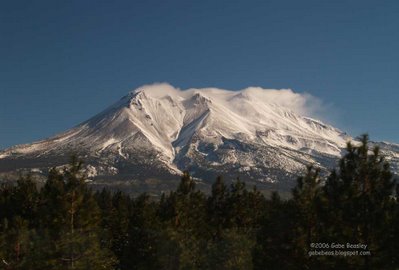
We passed MT. Shasta (I'm 99% sure) on our way into Oregon. I caught this and several other shots with my digital SLR. I was not going to use it on this trip back but found it impossible to not due so when I found conditions were so good. Wind sweeps over making for clouds on the top of the mountain in an otherwise cloudless sky, an indication of how big this mountain really is.
 My grandma, in the cold of winter, growing orchids as if it was more then very easy. I have many other shots and this was just a snapshot--at some point I will compile some more orchid shots--a number of them can be found under ALL PICTURES that I have taken in months passed. I shot these on my way back in November. My grandma deserves an honorary degree for this. She could grow an orchid on the moon.
My grandma, in the cold of winter, growing orchids as if it was more then very easy. I have many other shots and this was just a snapshot--at some point I will compile some more orchid shots--a number of them can be found under ALL PICTURES that I have taken in months passed. I shot these on my way back in November. My grandma deserves an honorary degree for this. She could grow an orchid on the moon.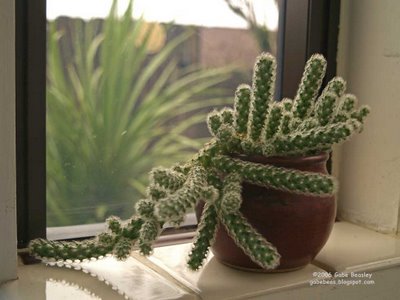
In her small greenhouse she keep dozens of plants from orchids to cactus as seen here--alive and very well. I have many pictures. Write me an e-mail or comment if you want to see more.
OLD CAMERA TIPS--READ THIS IF YOU USE GEAR 25 OR MORE YEARS OLD
DOES YOUR OLD CAMERA HAVE A SCREW LOOSE?
Is a dial now nearly impossible to turn or so loose you can't use it anymore?
A SERIOUS note here: I recently had a disaster when the 1:4,5/135 macro lens for my bellows scope destroyed itself. It failed in the same way as my 120 medium format TLR camera, everything just went to hell all the sudden. I should note that this failure was NOT due to old-age. It is entirely true that an old camera that has taken millions of pictures and been through a long photo-life can and will experience all kinds of stresses and could break or cause malfunctions that are not reversible or practically fixable in today's market. The same is true for lenses and it's all due to many kinds of metal fatigue and just ware and tear. However, don't be so quick to call it "old junk".
It turns out that all of the screws connecting the lens to the aperture on my 135 bellows lens had worked themselves nearly completely loose. A while back I decided with nothing to loose to take apart my broken 120 TLR to try to fix it. I went against fears and used gun-oil on some of the components, and managed to rebuild it's entire lens connection system and even get the shutter working better. The pictures proved how well this worked. Blur to very nice and it stayed that way. This first alerted me to this problem of loose screws and the damage they can cause when you are trying to get a broken complex camera to work. Those tiny screws so small that most small sets of screwdrivers have hard time with. They are vital to many old lenses and cameras. When it gets cold metal and oil changes pressures in the screws and mechanisms. When you have used and rattled around an older lens that has not been used for a long time--the tiny screws that often connect the lens controls can become very loose which can cause the control to move out of aliment and damage the aperture or other parts of the lens or simply make it unable to work at all. I want to note here for anyone interested in low budget gear and needing it---CHECK THE TINY SCREWS.
If they are very loose and seem ready to fall out, it is certainly a serious problem and you should slightly and carefully tighten them. This however is very complex topic and operation as the lens may allready be out of alignment. Just don't let your screws get loose! Old camera gear is not necessarily junk or garbage. Sometimes it needs what amounts to a tune-up. After I dismantled most of the lens that let me shoot at 600mm (that 135) which had failed--I found this problem again to my horror. So it was not "old age" that devastated this lens.
So if you use older lenses--Pay attention to screws and slight changes in lenses. If you feel a pull or movement that gets tight or wrong--check everything out as much as you can. Trying to oil lenses on your own is a very dangerous thing to do. I have succeeded twice in both these problems with my TLR 120 that I nearly entirely re-built and re-celebrated it's lens screws myself. DO NOT PUT OIL INTO THE SHUTTER MECHANISMS!
Fact is, metal fatigue is not something I have observed in very old and overused SLRs. In even using very old lenses and cameras my choices to work on it rather then give up has played off. Despite being told I was wasting my time, I pressed to solve the mystery with my "135 lens" and found to much of my despair that this lens was damaging itself and that it was a preventable situation! The screws had became so loose and gone past there limits forcing the lens to not spin but not stop until it crunched the aperture together when I pushed it too hard thinking it was just cold weather making the oil hard. Had I known that these loose screws needed to be tightened as was in my success 120 TLR--it could have been prevented. Generally do not oil old lenses that is often at least so as I have seen, not the problem. If there is nothing to loose give drops very carefully so that it does not reach the lens OR the shutter mechanisms! Most of it--is not about oil at all. It's the lens and the screws working loose.
A SCREW LOOSE!
Old dials on cameras and radios fall off and spin for this same reasons. Especially it seems--in the cold. Over time keeping the screws tight with a good set of tiny screw-drivers (like those used for glasses) is an easy thing to do that will preserve many of your old lenses. You must be very careful just to lightly tighten them and NOT strip them. Many of them are easy to strip so be careful. My 1940s Cintar also had to be adjusted in the same way. I had to tighten it's screws and oil some of the largely external gearing which proved very successful. I used a generic gun-oil to do this. I DO NOT recommend WD/40 as it is very light and I've heard can actually cause rust. I then tightened the dial screws and controls--and when they were re-alighted the camera put out a perfect roll of film with no distortions. Just make sure that if you use oil--you be very careful where you drop it. Getting oil inside a camera lens that cannot be opened with normal tools is the end of the camera or lens. Most of all--check those tiny screws.
I'm talking here about 60 to about 25 or so year old gear and lenses here. Metal fatigue does happen but more often then not I run across not only camera gear but old radios and other collectable gear which has this same problem. There are no lock nuts that can be put in these screws so they naturally work loose--keep them tight and your camera may take pictures for a very long time more then you might expect.
Being on a low-budget I just had to track down the exact real cause of why my very important macro lens failed. I was not satisfied simply to say "it's just old junk--" and throw it in a junk pile. I am an optimistic person, and believed there was something else wrong here. Recalling what happened with my TLR 120--I took a look at this devastated lens and found that ALL of the 4 screws that held it together on one side and acted as a grip had become so loose that just touching them with the driver would move them! I found the cause of why it failed. It was not rust or over-use and "old age". Its screws were completely worked loose. Since I started using it they had allready been getting loose and by using it I accelerated the process. Cold weather can also seize up oils used in lenses needing those screws to be tight even more. The resulting loss may not be able to be repaired but it could have definitely been prevented. It was a sad loss, but a lesson learned. I do not give up or give into blind pessimism. In so doing I have learned a great deal. I am still very proud of myself for re-building and re-working my TLR. Sadly--this lens probably cannot be repaired even if I get the proper lens tool to get deeper inside it where I would need to "reset" everything. So in old gear if you use it--CHECK THOSE MINI-SCREWS!
AND DO NOT STORE OLD CAMERAS IN LEATHER CASES!
Like guns, cameras stored in leather cases are exposed to TANNIC ACID which EATS AWAY at the shutter and other intricate mechanical systems. If you keep an old camera (like an old Cintar) in it's leather case for years the damage can be severe. Keep cameras in leather cases only when on a trip while you are using them. The leather also sucks away even oil in the camera, so this is an important problem that also applies to lenses.
VERY IMPORTANT PLEASE READ
ALL PICTURES -- PLEASE DO NOT FORGET!
In order to see the some 500+ (I cannot count them very easy) pictures and articles in this website you have to click on the MONTHS under ALL PICTURES on the RIGHT HAND side of my website. THIS IS THE ONLY WAY to see the entire site. There are 100s of pictures of everything from more plants and flowers to incredible insects and landscapes. Please, do not forget that my website DOES NOT END AT THE BOTTOM OF THIS PAGE or the end of these pages--many people have missed 90% of my website thinking that this first scroll down page is all there is. If I put all my pictures on this page it would take a whole day to load my site on your computer! Please use ALL PICTURES to check out my stuff if you are interested in seeing more!
1 comment:
Thanks for the welcome
Christmas Day falls on December 25. It is preceded by Christmas Eve on December 24, and in some countries is followed by Boxing Day on December 26. Some Eastern Orthodox Churches celebrate Christmas on January 7, which corresponds to December 25 on the Julian calendar. December 25 as a birthdate for Jesus is merely traditional, and is not thought to be his actual date of birth. Much respect!
Post a Comment